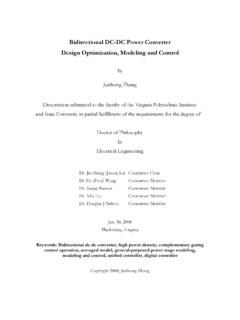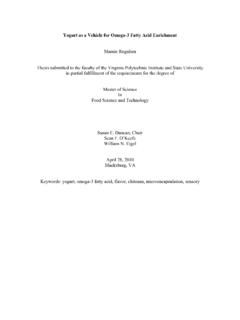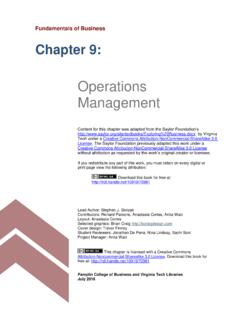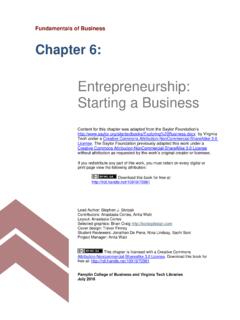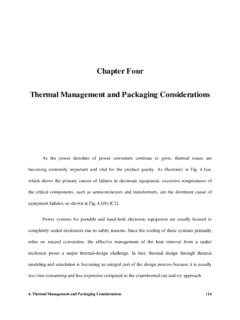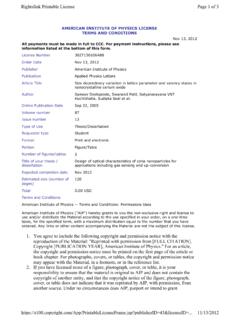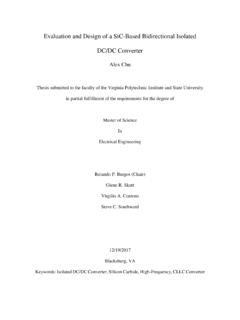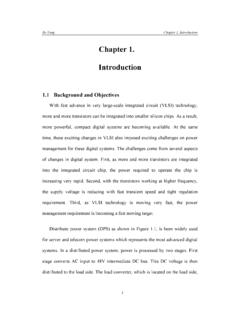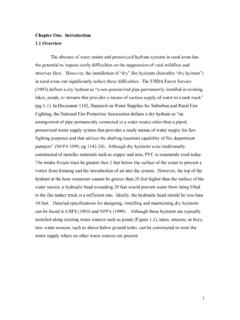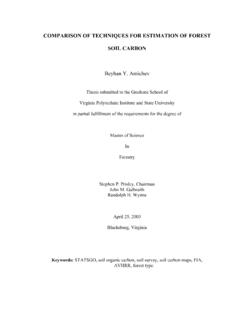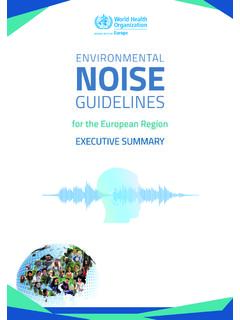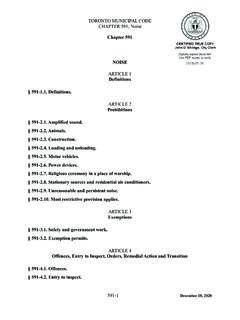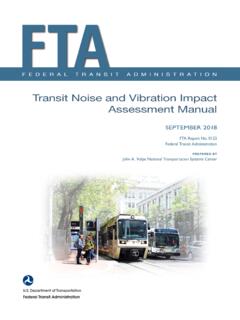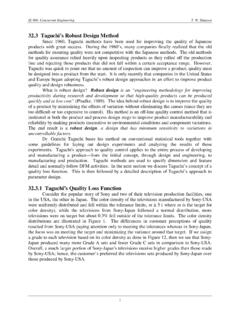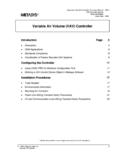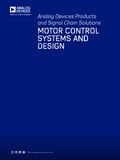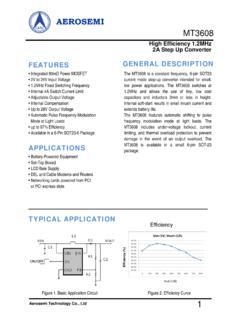Transcription of EMI Noise Reduction Techniques for High Frequency Power ...
1 EMI Noise Reduction Techniques for High Frequency Power Converters Yuchen Yang Dissertation submitted to the Faculty of the Virginia Polytechnic Institute and State University in partial fulfillment of the requirements for the degree of Doctor of Philosophy in Electrical Engineering APPROED Fred C. Lee (Chair) Qiang Li Jaime De La Ree Virgilio Centeno Steve C. Southward April 16th, 2018 Blacksburg, Virginia Keywords: Wide-band-gap devices, high Frequency , EMI, Magnetic integration 2018, Yuchen Yang EMI Noise Reduction Techniques for High Frequency Power Converters Yuchen Yang Abstract Switch mode Power supplies are widely used in different applications. High efficiency and high Power density are two driving forces for Power supply systems.
2 However, high dv/dt and di/dt in switch mode Power supplies will cause severe EMI Noise issue. In a typical front-end converter, the EMI filter usually occupies 1/3 to 1/4 volume of total converter. Hence, reducing the EMI Noise of Power converter can help reduce the volume of EMI filter and improving the total Power density of the converter. The EMI Noise can be separated as differential mode (DM) Noise and common mode (CM) Noise . For off-line switch mode Power supplies, DM Noise is dominated by PFC converter. CM Noise is a more complicated issue. It is contributed by both PFC converter and DC/DC converter. The DM Noise is contributed by input current ripple. Therefore, one method to reduce DM Noise is interleaving. There are three methods to reduce CM Noise : symmetry, balance and shielding.
3 The idea of symmetry concept is generating another dv/dt source to cancel the original dv/dt source. However, this method is very difficult to achieve and usually has more loss. The balance technique forms a Wheatstone bridge circuit to minimize the CM Noise . However, the balance technique cannot achieve very good attenuation at high Frequency due to parasitics. Shielding technique is very popular in isolated DC-DC converters to reduce CM Noise . However, the previous shielding method requires precise control of parasitic capacitance and dv/dt. It is very difficult to achieve good CM Noise attenuation in mass production. In this dissertation, a novel one-layer shielding method for PCB winding transformer is provided.
4 This shielding technique can block CM Noise from primary side and also cancel the CM Noise from secondary side. In addition, shielding does not increase the loss of converter too much. Furthermore, this shielding technique can be applied to matrix transformer structure. For matrix transformer LLC converter, the inter-winding capacitor is very large and will cause severe CM Noise problem. By adding shielding layer, CM Noise has been greatly reduced. Although flyback and LLC resonant converter are used as examples to demonstrate the concept, the novel shielding technique can also be applied to other topologies that have similar transformer structure. With Wide-band-gap Power devices, the switching Frequency of Power converter can be pushed 10 times higher than traditional Si based converters.
5 This provides an opportunity to use PCB winding magnetics. In order to reduce the switching loss, critical conduction mode is used in PFC converter. Because of high AC current in the inductor winding, litz wire was used to build the inductor. However, with coupled inductor concept and the proposed winding structure, CRM inductor is integrate into PCB winding for the first time. Furthermore, balance technique is applied to reduce CM Noise for PFC converter. With PCB winding, the balance technique has better high Frequency performance. The PCB winding inductor can achieve high Power density, high efficiency and automated manufacture. Traditionally, two-stage EMI filter was utilized to achieve required EMI Noise attenuation.
6 With the developed high Frequency , low EMI Noise converter, single-stage EMI filter can be applied. However, there are self-parasitic and mutual parasitic components to impact the filter performance on high Frequency . The near-field measurement is utilized to visualize the magnetic flux near those filter components. Thus, a better filter design and layout can be achieved to have better high Frequency performance. EMI Noise Reduction Techniques for High Frequency Power Converters Yuchen Yang General Audience Abstract Switch mode Power supplies are widely used in different applications. High efficiency and high Power density are two driving forces for Power supply systems. In a world full of electronic devices, it is very important that these devices can work properly in a complicated electromagnetic environment.
7 Thus, electromagnetic compatibility (EMC) is a significant characteristic of electronic devices. However, high dv/dt and di/dt in switch mode Power supplies will cause severe EMI Noise issue. In a typical front-end converter, the EMI filter usually occupies 1/3 to 1/4 volume of total converter. Hence, reducing the EMI Noise of Power converter can help reduce the volume of EMI filter and improving the total Power density of the converter. In this dissertation, several methods to reduce EMI Noise are proposed and analyzed. First, the shielding method for PCB winding transformer is proposed. It can effectively reduce EMI Noise at wide Frequency range. Second, balance technique is applied to reduce EMI Noise of PFC converter.
8 Traditionally, two-stage EMI filter was utilized to achieve required EMI Noise attenuation. With the developed high Frequency , low EMI Noise converter, single-stage EMI filter can be applied. However, there are self-parasitic and mutual parasitic components to impact the filter performance on high Frequency . The near-field measurement is utilized to visualize the magnetic flux near those filter components. Thus, a better filter design and layout can be achieved to have better high Frequency performance. v To My Family My parents: Shijun Yang and Ying Lu My parents-in-law: Jiquan Li and Qiusha Dai My wife: Zhuxuan Li vi Acknowledgments First and foremost I would like to thank my advisor, Dr. Fred C. Lee for his guidance, encouragement and education.
9 It is him who opens the door of Power electronics for me and show me the right way to do research. He is not only a wise and farsighted advisor in academic, but also a mentor in life. He pointed out my character weaknesses and helped me become a better person. His profound knowledge, rich experience, rigorous attitude, and challenging spirit have been a great value for me. It is most honored to be advised by Dr. Lee. The experience of studying at CPES is a life-changing experience. I am very grateful to my other committee members Dr. Qiang Li, Dr. Jaime De La Ree, Dr. Virgilio Centeno, and Dr. Steve Southward. I still remember the weekly meeting with Dr. Li when I first came to CPES. He taught me how to start a research and how to express my ideas.
10 Thanks for all the constructive and helpful suggestions offered by Dr. Li. My very special thanks go to my colleagues Dr. Zhengyang Liu and Mr. Bin Li. As a team, we have worked on several projects. I cannot accomplish so much without their help. I really appreciate the discussions and suggestions from Dr. Dushan Boroyevich, Dr. Khai Ngo, Dr. Rolando Burgos, and Dr. Guo-Quan Lu in High Density Integration (HDI) group. I really want to thank all my colleagues in the Power Management Consortium (PMC) group: Dr. David Reusch, Dr. Mingkai Mu, Dr. Yingyi Yan, Dr. Weiyi Feng, Dr. Daocheng Huang, Dr. Zijian Wang, Mr. Shu Ji, Mr. Haoran Wu, Dr. Yipeng Su, Mr. Wei Zhang, Mr. Li Jiang, Dr. Shuilin Tian, Dr. Pei-Hsin Liu, Dr. Dongbin Hou, Dr.
